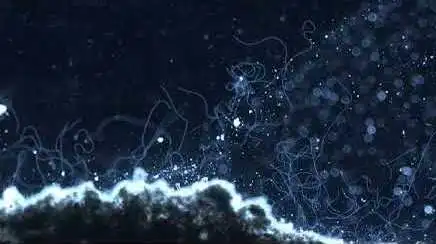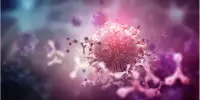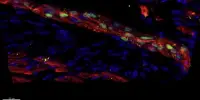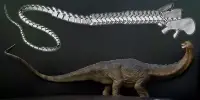The small motorboat anchors in the middle of the Chesapeake Bay. Shrieks of wintering birds assault the vessel’s five crew members, all clad in bright orange flotation suits. One of the crew slowly pulls a rope out of the water to retrieve a plastic tube, about the length of a person’s arm, and filled with mud from the bottom of the bay. As the tube is hauled on board, the stench of rotten eggs fills the air.
“Chesapeake Bay mud is stinky,” says Sairah Malkin, a biogeochemist at the University of Maryland Center for Environmental Science in Cambridge who is aboard the boat. The smell comes from sulfuric chemicals called sulfides within the mud. They’re quite toxic, Malkin explains.
Malkin and her team venture out onto the bay every couple of months to sample the foul muck and track the abundance of squiggling mud dwellers called cable bacteria. The microbes are living wires: Their threadlike bodies — thinner than human hair — can channel electricity.
Cable bacteria use that power to chemically rewire their surroundings. While some microbes in the area produce sulfides, the cable bacteria remove those chemicals and help prevent them from moving up into the water column. By managing sulfides, cable bacteria may protect fish, crustaceans, and other aquatic organisms from a “toxic nightmare,” says Filip Meysman, a biogeochemist at the University of Antwerp in Belgium. “They’re kind of like guardian angels in these coastal ecosystems.”
Now, scientists are studying how these living electrical filaments might do good in other ways. Laboratory experiments show that cable bacteria can support other microbes that consume crude oil, so researchers are investigating how to encourage the bacteria’s growth to help clean up oil spills. What’s more, researchers have shown that cable bacteria could help slash emissions of a potent greenhouse gas — methane — into the atmosphere.
There’s plenty of evidence that cable bacteria exert a strong influence over their microbial neighbors, Meysman says. The next step, he says, is to figure out how to channel that influence for the greater good.
Laboratory experiments show that cable bacteria can support other microbes that consume crude oil, so researchers are investigating how to encourage the bacteria’s growth to help clean up oil spills.
Sairah Malkin
Electric life
Under the microscope, cable bacteria resemble long sausage links. Their multicellular bodies can grow up to 5 centimeters long. Embedded in the envelope of each cell are parallel “wires” of conductive proteins, which the bacteria use to channel electrons. According to Meysman, the wires are more conductive than the semiconductors found in electronics.
About a decade ago, a team of scientists first discovered cable bacteria, in sediment collected from the bottom of Denmark’s Aarhus Bay. Since then, cable bacteria have been found on at least four continents, in streams, lakes, estuaries, and coastal environments. “Name me a country, and I’ll show you where the cable bacteria are,” Meysman says.
Most often, cable bacteria nestle shallow in the sediment, with one end positioned near the surface where there is oxygen and the other end plugged into deeper, sulfide-rich zones. Using their filamentous bodies as electrical conduits, cable bacteria snatch electrons from sulfides on one end and off-load them to oxygen — an eager electron acceptor — at the other, says Nicole Geerlings, a biogeochemist at Utrecht University in the Netherlands. Similar to how batteries charge and release energy by transferring electrons between an anode and cathode, cable bacteria power themselves by channeling electrons, she says. “The electron transport gives [cable bacteria] energy.”
This unique lifestyle allows cable bacteria to survive in an environment that many organisms could not endure.
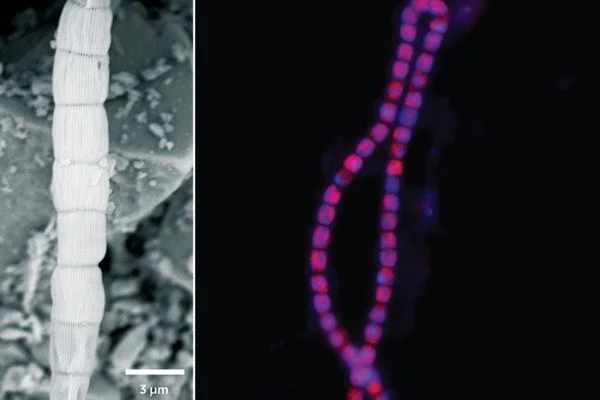
Toxic fire wall
In 2015, Malkin, Meysman, and colleagues reported that cable bacteria may help to counteract the onset of euxinia — a fatal buildup of sulfides in oxygen-starved bodies of water. Euxinia can trigger mass die-offs of fish, crustaceans, and other aquatic life.
The lethal phenomenon can occur after fertilizers or sewage are washed into the sea or lakes. That flow of nutrients can trigger algal blooms. When those nutrients are depleted, the blooms die, and large quantities of organic matter sink and accumulate on the sediment. Microbes then decompose the dead material, devouring much of the oxygen in the surrounding water in the process. When oxygen levels become critically low, sulfides may begin to leak from the sediment into the water, giving rise to euxinia.
Oil cleanup
Some researchers are trying to harness the bacteria’s electrical abilities to tackle another devastating threat to coastal ecosystems — oil spills.
When an oil spill happens in a body of water, booms, skimmers or sorbents are often deployed to limit the spread of hydrocarbons on the surface. But oil may also wash onto beaches, mix with sediments in shallow waters, and aggregate onto sinking particles of organic debris, hitching a ride to the seafloor.
Cleaning up oil at the bottom of the sea is a difficult job, says Ugo Marzocchi, a biogeochemist at Aarhus University in Denmark. “I am not aware of a very effective way to remove hydrocarbons from the seafloor,” he says. “In inland freshwater systems, what is generally done is to dig out the sediments,” he says, an expensive strategy that would be even more costly at sea.
Some soil-dwelling microorganisms can use hydrocarbons to fuel their metabolism, and researchers have been studying how some of these oil burners might assist in the cleanup of contaminated sediments. But as they break down hydrocarbons, the microbes generate those concerning sulfides, which are detrimental to the microbes’ own survival, Marzocchi says. In other words, the microbes can help clean up the oil for only so long before they’re overwhelmed by their own toxic waste.
Cable bacteria might be just the solution, Marzocchi thought. In 2016, researchers reported finding evidence of the electrical microbes in a tar oil-contaminated groundwater aquifer in Germany. Knowing that cable bacteria could occupy sediments contaminated with hydrocarbons, Marzocchi and colleagues reasoned that these bacteria might be able to assist oil-burning microbes and accelerate oil cleanup.
The researchers filled several containers with oil-contaminated sediment from Aarhus Bay — which contained naturally occurring oil-eating bacteria. The group then injected a few containers with cable bacteria and monitored the degree of hydrocarbon degradation in all of the containers over seven weeks. By the end of the test, the concentration of alkanes — a type of hydrocarbon — in the sediment with cable bacteria had dropped from 0.125 milligrams per gram of sediment to 0.086 milligrams per gram — a 31 percent drop. That’s 23 percentage points more than the 9 percent decrease in the control samples. Cable bacteria helped accelerate the metabolic activity of their oil-eating neighbors by converting the toxic sulfides into sulfates.
